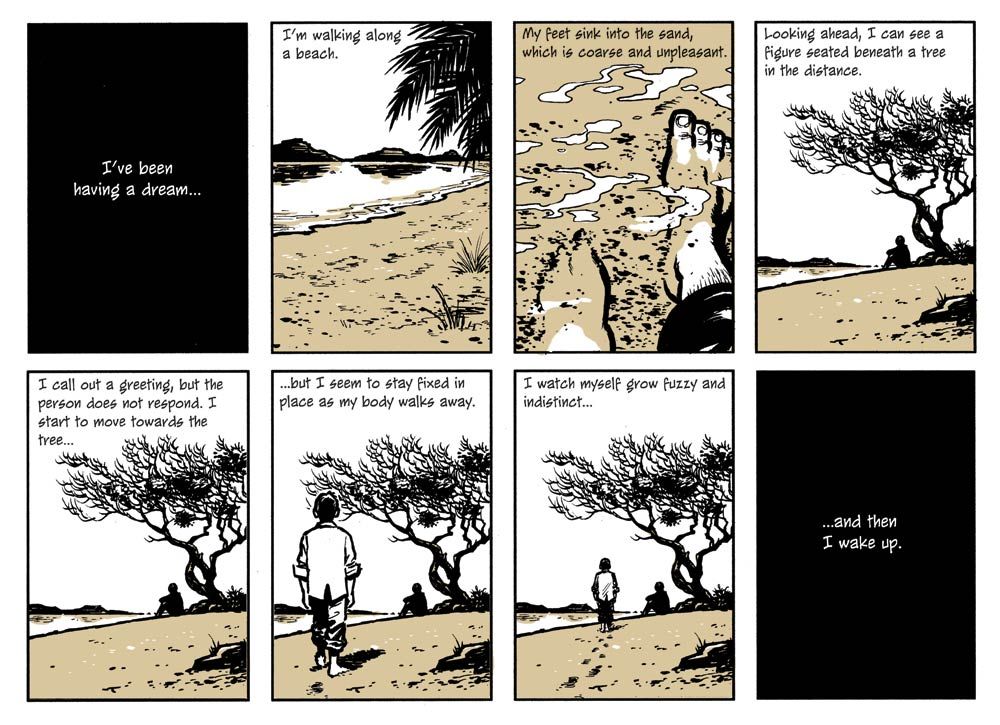(SPOILER ALERT for Sin Titulo, Lost, The X-Files and probably iCarly.)
Cameron Stewart has a clean, distinguishable artistic style, with a hint of a manga influence, but with panel-to-panel transitions that are more delicate and subdued. His art has become quite popular, with his redesign of Batgirls costume creating something of an Internet sensation. While his artwork lends itself easily to all-ages comics, he's frequently collaborated with Grant Morrison on such titles as Seaguy, Seven Soldiers and Batman & Robin.
However, his art has also appeared in strange psychological thrillers. In 2010, his webcomic Sin Titulo won the Eisner Award for Best Digital Comic, after it had already won the 2009 Shuster Award in the same category.
Psychological mysteries are a tricky thing, though. Getting readers hooked is easy: Establish a mood, craft a paranoid atmosphere hinting at a truth beyond what you know. It's catnip.
But there's a risk if you get too vague or are too bold about telling an nontraditional narrative to throw readers off the scent. The disorientation can often be too much, and some of the twists and turns eventually start becoming ridiculous. Pretty soon, without any clear stakes, it becomes easy to abandon the story.
I once compared Sin Titulo favorably to Lost, as both mysteries are eerie and tantalizing. A woman with sunglasses who has white noise in her pupils? Cool! A mysterious orderly at the center of a retirement home conspiracy? Wicked! A spiky crab-thing that spits oil? Crazy! Each new page provided new visions of madness.
Of course, there's a big downside to being compared to Lost -- sometimes, the mysteries are so fantastic that the resolution can't match the build-up.
That's not to say all threads in Sin Titulo are given closure; some resolutions are left vague. At the end, our protagonist walks into a store, and then two policemen enter. We know earlier that Alex is wanted in connection with one assault and one bloody disembowelment. But the officers barely look at him. I almost groaned. If this was one of those "it was all a dream endings" ... Stewart, however, leaves it open to interpretation.
We also get hints that Wesley, the orderly who's been doggedly pursuing Alex from the beginning, may not be quite human. So what is he, exactly? An alien bounty hunter like on The X-Files? No clue.
I'm resigned to never finding answers in mystery stories, because the mystery itself is usually the best part. However, Sin Titulo does provide an answer to the big question: What is this alternate reality Alex finds himself in? Well buckle in, because we're rocketing off to Planet Exposition!
Alex has been receiving transmissions that let him peek into "Sin Titulo," a world created from a painting by Stanislav Vacek, who was determined to craft a new reality rather than just a mere imitation. (How?) The painter could create most things on his own, but his world lacked something. The presence of human beings, such as Alex's dad and the mystery lady, was instrumental in populating the new world with memories.
Sure, that makes sense as much as anything. The hand-waving "this is a brand-new world where weirdness can be explained as kinks that needed to be worked out" explanation.
Also, Alex needs to stop blaming himself, because get over your grandpa's death already.
I imagine that this feeling of dissatisfaction may be the same thing some Lost fans felt when they discovered the island was this Pandora's Box where evil was held in check by a big stopper at the bottom of a cave. Or how X-Files fans felt when the conspiracy mythos somehow became a bouillabaisse of alien-human hybrids, black oil and bees. Sin Titulo follows the same pattern: starting off strong, but descending into nonsense once the answers started coming. Seriously, an alternate reality made from the brushstrokes of a really, really good painting?
Ah, well. The art was nice.

